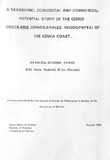| dc.description.abstract | A study was carried out on the taxonomy, ecology and the yield as well as properties of the polysaccharides of the marine algal genus Gracilaria, which is
one of the genera of commercial importance worldwide. Eight species of the
genus were investigated and reported with respect to their morphological and
anatomical characteristics. The species are: G. corticata, G. crassa, G. edulis, G.
fergusonii, G. millardetii, G. salicornia, G. yerrucosa and Gracilaria sp. Two species, G. corticata and G. salicornia were observed to be highly variable
morphologically and their variability depended on the prevailing physiological and
ecological conditions. As taxonomic features, the branching pattern and whether
the thallus is terete or flattened was shown to be quite consistent while the other
features were observed to exhibit a lot of variations. Due to morphological
plasticity previous workers reported a total of thirteen species for the Kenyan taxa
and it has now been established that some of these are but synonyms.
With respect to their distribution along the Kenya coast, G. salicornia was
observed to be the- most common followed by G. corticata and then G. crassa.
The rest would be classified as not common. The north-south distribution of the
species did not show any specific trend though stations with rocky platforms had
a wider variety of species than the sandy and mangrove beaches. Most of the
species grew on rough substrate in the eulittoral zone with a higher percentage in
the lower eulittoral. Only G. salicornia was observed to extend from the upper
eulittoral to the sublittoral in its distribution while G. verrucosa was basically
sublittoral. One feature that was found to be common to all the eulittoral plants,
with an exception of one ecotype of G. salicornia, is that they were either growing
in pools or lagoons and as such they were not exposed to stress due to desiccation
during low tide.
Studies on the seasonality pattern of the genus showed that seasonal
abundance of different species varied with time and geographical location.
Nonetheless, a general single peak for the genus was evident between the months
of September and December. G. verrucosa, however, was observed to have its
peak biomass in July/August and it was also observed to spend part of its life
cycle buried in sand. Implications of how environmental factors contribute to.
the seasonality pattern of the plants are discussed.
Based on their availability in adequate quantities six species were tested for
their agar yield and quality. The species tested were G. crassa, G. corticata, G.
millardetii, G. salicornia, G. verrucosa and Gracilaria sp. Agar was extracted
from as many different ecotypes as there were, covering the major seasons when
the plants were available. Chemical and physical properties of the extracts were
studied and comparisons made. Native agar yield from hot water extract was
observed to range from 8.1 %-30.3% of dry weight with G. vcrrucosa and G.
salicornia yielding the highest and the lowest amounts respectively. Gel strengths
of 1.5 % solution of the native extracts was observed to be highest in G. verrucosa
(220gm/cm2) and lowest in G. corticata « 60gm/cm2) whereas the highest gelling
temperature was recorded from Gracilaria sp. extract (40.4°C) and the lowest from
G. verrucosa extract (28.9°C). The melting temperature, on the other hand, was
highest in agar from G. crassa (94.SOC) and lowest in that of G. corticata
(79.8°C).
On determining the concentration of 3,6-anhydrogalactose in the different
species it was found that G. verrucosa agar had the highest content (23 %) while
G. corticata had the least (14.5%). The sulphate content was highest in agar from
G. corticata and lowest in-that of Gracilaria sp. Treatment of either the plant or
native agar extract with alkali (NaOH) only improved the chemical and physical
quality of agar from G. crassa, G. saliomnia, G. verrucosa and Gracilaria sp.
while agar from G. corticata and G. millardetii did not improve I much. The
yield, physical and chemical properties of these extracts were observed to vary not
only from species to species but also from one ecotype to the other and from
season to season. When the observations made in this study were compared with
those of a commercial agar Difco Bacto Agar, it was established that G. verrucosa
yielded agar that was closest to it in terms of their properties.
Implications of the results obtained in this study are discussed with respect
to seaweed farming. G. verrucosa, G. crassa and some ecotypes of G. salicornia
have been recommended for this. Further investigations with a view to culturing
them in mass would be a worthy course. | en |

